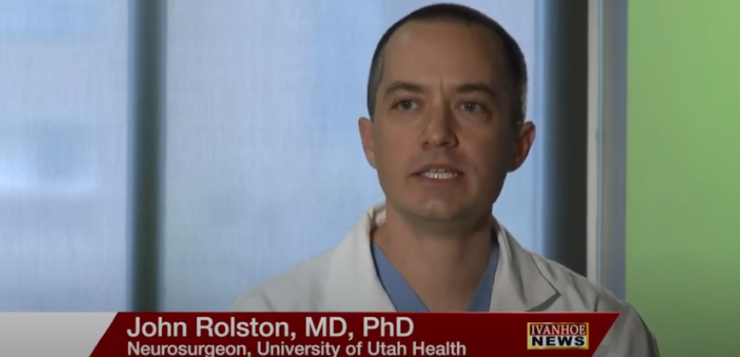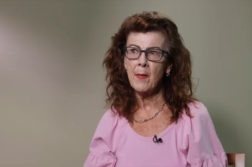John Rolston, MD, PhD, Director of Functional Neurosurgery at University of Utah, talks about a new technique of focused ultrasound to relieve shaking in essential tremor patients.
What are essential tremors?
ROLSTON: An essential tremor is a type of involuntary tremor or movement of the body that usually happens during actions like a tremor of the hand while moving it or while trying to maintain a posture like keeping your hand still. That is in comparison to a resting tremor that you might get during Parkinson’s, which happens when you’re not doing anything.
What really surprised me with Janice was that she started getting tremors in her early 40’s. I never hear of people so young with tremors. Is this common?
ROLSTON: Yes. Essential tremors usually have two times where they come on. One group happens in the teenage years or early 20’s, and that’s the juvenile onset essential tremor. Then, there’s another group that starts more in the 50’s or 60’s, but sometimes as early as 40’s, where the tremors become noticeable and ultimately can become disabling.
Janice was worried her life would never be the same because of such a debilitating problem. Do you hear that a lot from patients?
ROLSTON: Probably about half of patients with essential tremor eventually have disabling or debilitating tremors where they interfere with things like eating, dressing, hygiene, writing, or even using the phone. So, it’s very common, unfortunately, for these tremors to become very disabling.
How long does it take for the tremors to go away, and how does it happen?
ROLSTON: When we treat tremors with focused ultrasound or other procedures, we often see a near immediate change in the tremor. This is because we know pretty well where these are happening inside the brain. We can target that one place with very precise pinpoint accuracy and can see that change nearly immediately. It’s very miraculous when it happens.
The patient is awake during treatment? Can you walk us through the whole process?
ROLSTON: Sure. The area we’re targeting in the brain to treat the tremors is very deep inside the brain and doesn’t show up very well in the MRI. We have a pretty good idea of where it is, but not a perfect idea. We do these procedures with the patient awake so we can get real time feedback with how we’re doing and can deliver temporary short doses of energy stun the brain to see what happens, to see if the tremor gets better, and to make sure we’re not getting side effects. If we’re happy with how things are and the patient’s giving us good feedback, we can make that change permanent.
What kind of difficulties do the patients experience?
ROLSTON: A lot of our patients have difficulty writing and doing other tasks with their hands, which is why they come to us. One of the main areas we focus on is writing, handwriting. When we start, we have them do some tests, drawing spirals, trying to draw straight lines or trying to sign their names. Many of the patients can’t even do that. They can’t keep pen to paper long enough to sign their name. As we progress, we deliver a first small dose, a tiny dose, and see if that’s having the right effect that we’re looking for with no side effects. If it does, we’ll turn up the energy and keep repeating this until we get to a level where the tremor is gone. It can often be between five and ten different occasions before we get to where we want to be.
Where exactly in the brain is this area?
ROLSTON: The area we’re targeting is a small part of the brain, the size of a pea, called the ventral intermediate nucleus of the thalamus. You have two of these, one on the left and one on the right. The one of the left helps control the right side of the body’s tremors and vice versa for the other one.
Do they come out of this procedure not being 100 percent back to normal? The tumor may be gone, but do they have some side effects for a few weeks?
ROLSTON: Yes, often people do. The areas that are close by, right behind the area we’re targeting, is one of the parts of the brain that brings sensory information. So, touch from the hand in the face into the brain and right to the outside of it is part that brings motor commands from the brain to the spinal cord. If there’s any sort of swelling from the area, we’re targeting. That can sometimes cause numbness or a little instability in the person’s walking, which can last for about a month or so until that swelling goes down.
Is there any risk that’s permanent?
ROLSTON: There’s always a risk in any procedure we do that some of these things could last long-term. That risk is pretty low. That’s one of the reasons we try to protect people by doing these procedures awake. If we do notice any side effects, we can immediately retarget where we’re putting the ultrasound energy to avoid those being permanent side effects.
Can this help anyone with essential tremors or is it a specific group?
ROLSTON: We do a lot of analysis with these patients to make sure that the tremor is really disabling to them, to make sure that it’s worth any sort of risk they might have for the procedure and to make sure that is truly essential tremor. There’s a lot of tremors that can look like this that might not be essential tremor and might not respond as well.
Can you walk us through the whole procedure?
ROLSTON: Sure. The day of the procedure, the person comes in and has to get their head completely shaved. We can’t have hair bouncing or deflecting any of the sound waves from the ultrasound machine, which is why that’s important for us. Once that’s done, we fix their head in a titanium special frame that keeps the head very still because we don’t want to hit any other place in the brain. We want to make sure we get to that one special spot. Once that’s ready, we get them on the MRI table. They sit there for the next hour and a half or so. We first get a new map of their brain to help target and then start delivering these little doses of energy. Each time we deliver, the ultrasound takes about 10 to 15 seconds, so very brief. After that, we pull them out of the MRI, talk to them, assess how the symptoms are, or see if there’s any side effects. If we’re happy, we put them back in and keep working on this. When we’re all done, we take the helmet off, usually do one last MRI just to get a new picture of their brain at baseline and let them go.
You are really changing people’s lives? You’re giving them immediate gratification?
ROLSTON: Yes. That’s why I got into neurosurgery in the first place, is to specifically be able to help people with these treatments that we’ve known about for a long time. We have new technologies to do these things now than we used to, like focused ultrasound. But a lot of the stuff we can do in neurosurgery has been around since the 50’s and 60’s, and being able to make such an important change in someone’s life is really gratifying and why I do what I do.
Interview conducted by Ivanhoe Broadcast News.
END OF INTERVIEW
This information is intended for additional research purposes only. It is not to be used as a prescription or advice from Ivanhoe Broadcast News, Inc. or any medical professional interviewed. Ivanhoe Broadcast News, Inc. assumes no responsibility for the depth or accuracy of physician statements. Procedures or medicines apply to different people and medical factors; always consult your physician on medical matters.
If you would like more information, please contact:
Suzanne Winchester
801.581.3102
suzanne.winchester@hsc.utah.edu
Sign up for a free weekly e-mail on Medical Breakthroughs called First to Know by clicking here




